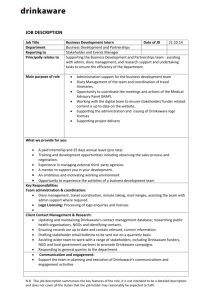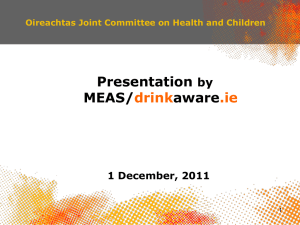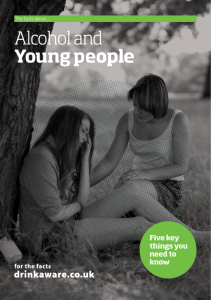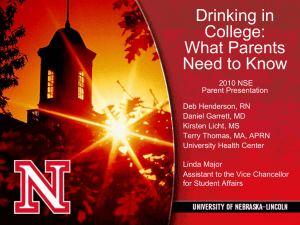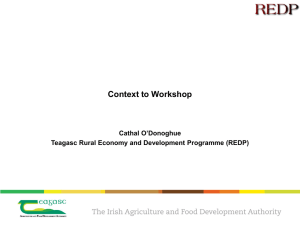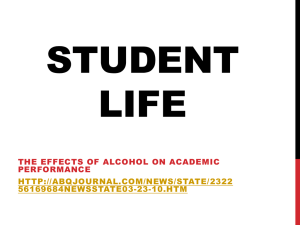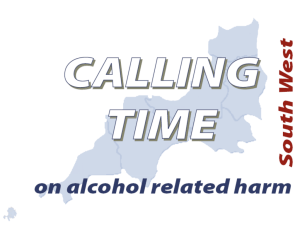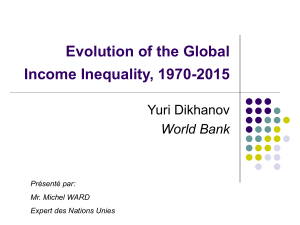Stakeholder discussions
advertisement
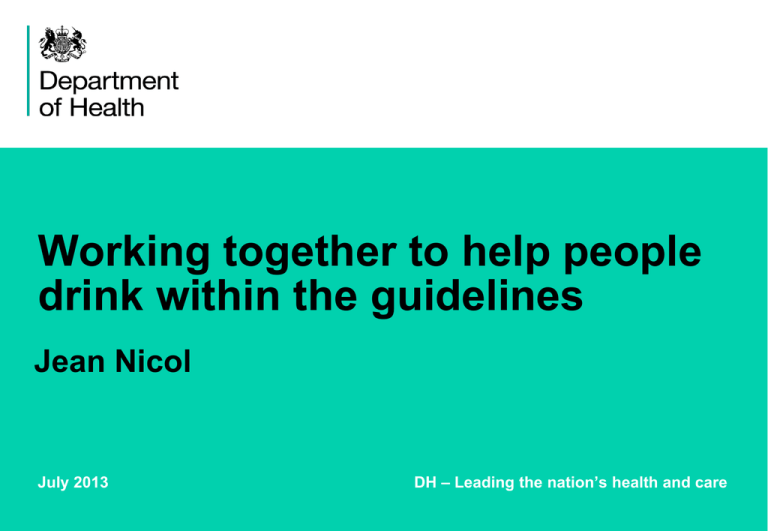
Working together to help people drink within the guidelines Jean Nicol July 2013 DH – Leading the nation’s health and care Levels of binge drinking among 15-16 year olds in the UK compare poorly with many other European countries Binge drinking in 15-16 year old students in Europe, defined as 5+ drinks on a single occasion, 3 or more times in 30 days Source: ESPAD 2007 (Hibbell et al 2009). Data for Denmark and Spain has limited comparability. (Supporting evidence for Strategy) 2 2 Estimated cost of alcohol misuse in England Around £21bn per year made up of: NHS costs, at about £3.5bn per year Alcohol-related crime, at £11bn per year 3 Lost productivity due to alcohol, at about £7.3bn per year Health harms have continued to grow Over the last ten years • • • • • • • 4 Alcohol-attributable deaths in England rose by 7%, from 14,000 in 2001 to 15,000 in 2010. In contrast, deaths from all causes in England fell by 7% over this period Over the same period, alcohol-specific deaths rose by 30% The rate of liver deaths in the UK has nearly quadrupled over 40 years, a very different trend from most other European countries Approximately 60% of people with liver disease in England have alcoholic liver disease, which accounts for 84% of liver deaths. In addition, the rate of alcohol-related hospital admissions has also continued to rise by an average of 4% each year over the eight years 2002/03 to 2010/11 Alcohol is now one the three biggest lifestyle risk factors for disease and death in the United Kingdom, after smoking and obesity. In addition, in 2010/11, there were around 930,000 (44%) violent incidents in England and Wales where the victim believed the offender to be under the influence of alcohol, this rose to 58% in instances of stranger violence Health harm Standardised Death Rate, chronic liver disease and cirrhosis, age 0-64 per 100,000 France Italy UK 5 Source: WHO/Europe, European HFA Database, January 2012 (Supporting evidence for Strategy) 5 Highest consuming 10% of the population drinking more than 40% of all alcohol consumed in the UK 50 44.9 45 % of total alcohol consumed 40 35 30 25 20.7 20 13.3 15 9.8 10 5.9 5 0 0.0 0.0 1st Decile 2nd Decile 3rd Decile 1.6 3.4 0 6 4th Decile 5th Decile 6th Decile 7th Decile 8th Decile 9th Decile 10th Decile Policy options for alcohol price regulation: the importance of modelling population heterogeneity, Meier et al, Addiction 105, 383-393, 2009 (Supporting evidence for the Strategy) 6 “We are working towards the clear ambitions to radically reshape our approach to alcohol and reduce the number of people drinking to excess” The outcomes want to see are: A change in behaviour so that people think it is not acceptable to drink in ways that could cause harm to themselves or others A reduction in the amount of alcohol-fuelled violent crime A reduction in the number of adults drinking above the NHS guidelines A reduction in the number of people “binge drinking” A reduction in the number of alcohol-related deaths A sustained reduction in both the numbers of 11-15 year olds drinking alcohol and the amounts consumed 7 7 Public health is everyone’s responsibility and there is a role for all of us, working together to help people drink within the guidelines Local areas • Promote identification and brief advice (IBA) • Deploy alcohol liaison nurses (health workers) in secondary care settings • Improve specialist treatment Responsibility Deal • Health messages on products, and in on/off trade • Comprehensive advertising and marketing regime • Promote lower strength and smaller sizes • Offer tools to local areas and employers Government • Licensing and enforcement • Pricing and Taxation • Set funding and outcomes framework for public health and the NHS • Encourage lower strength and smaller sizes • Social Marketing 8 • Number of IBAs delivered by setting • Number in treatment • Number of Cumulative Impact Policies (including in the off trade) • Percentage of products labelled • % stores/outlets with health messages • Breaches of advertising and marketing rules • Sales of lower-strength and non-alcoholic beer/wine • Units reduced per drinker from volume and strength measures • Schools/workplaces/ local areas using tools • Awareness of C4L alcohol health harms campaign Improve • Unit awareness • Awareness of health harms • Awareness of harms during pregnancy • Self-identification behaviours Reduce • Alcohol-related hospital admissions • Number of underage purchases Reduce • • • • • • Alcohol fuelled violent crime Percentage believing getting drunk is acceptable Number of adults drinking above lower-risk guidelines Number of adults binge drinking Number of alcohol related deaths Percentage of 15 year olds drinking and the amount they drink • Cost to society • Cost to NHS 8 8 SOCIAL MARKETING Encouraging behaviour change in the drinkers of tomorrow Target Group Information Campaigns Drinkaware Change4Life Drinkaware Young people and parents Website Education 18-24 year olds Website: Units Guidelines Self-identification Health Harm Digital tools Leaflets 25+ year olds Government Other websites FRANK DH Young People Social Marketing Strategy C4L NHS Choices CRUK British Heart Foundation National Liver Trust NHS Health Check IBA (GP and other settings) 9 9 Drinkaware • Drinkaware was established at the beginning of 2007, following a Memorandum of Understanding between Government, the public health community and industry • Responsibility Deal pledge by industry to support Drinkaware - maintain levels of financial support and in-kind funding as set out in the memorandum of understanding. • As a market provider, Drinkaware is well placed to deliver key messages and can reach environments (e.g. pubs) that no current Government brand can. • Government is committed to making Drinkaware work and we have a shared objective to use industry resources and skills, to help change the behaviour of consumers who drink above the lower-risk guidelines • The Government is pleased with the way that Drinkaware has developed and wants it to do even better. The recent audit will help in planning how it can meet new challenges and have a long and successful future. 10 DH – Leading the nation’s health and care The role of business in helping people to drink within the guidelines Business is a powerful influence in our lives. Business can reach consumers and deliver information in ways that other organisations cannot. The Responsibility Deal challenges business and other organisations to lead the way in positively shaping and creating an environment that supports people to make informed, balanced choices and help them live healthier lives. Organisations signing up to the Responsibility Deal commit to take action to improve public health. This action is expressed as a series of pledges covering food, alcohol, physical activity and health at work. Over 535 partners have already signed up to the Responsibility Deal 11 The Responsibility Deal structure Core Commitments 1. We recognise that we have a vital role to play in improving people’s health. 2. We will encourage and enable people to adopt a healthier diet. 3. We will foster a culture of responsible drinking, which will help people to drink within guidelines 4. We will encourage and assist people to become more physically active 5. We will actively support our workforce to lead healthier lives Supporting Pledges a. We will support the approach of the Public Health Responsibility Deal and encourage other organisations to sign up. b. We acknowledge that the Deal's strength comes from organisations of different types across varying sectors working together to improve people's health. c. We will contribute to the monitoring and evaluation of progress against the pledges. d. Where we offer people information to help make healthier choices, we will use messages which are consistent with Government public health advice. e. We will broaden and deepen the impact of the Public Health Responsibility Deal by working to develop further pledges in support of the five core commitments. 12 Alcohol pledges A1. Alcohol labelling Alcohol beverage companies will label their products with unit and health information. A2. Awareness of alcohol units in the on-trade / A3. Awareness of alcohol units, in the off-trade On and off-trade alcohol retailers will provide unit and health information to consumers. A4. Tackling under-age alcohol sales Business will promote and encourage the use of the Challenge 21 and Challenge 25 schemes. A5. Support for Drinkaware Industry will support the Drinkaware Trust through cash and in-kind funding. A6. Advertising and marketing alcohol Industry will follow best practice and adhere to the Code of Practice on the marketing of alcoholic drinks. A7. Community actions to tackle alcohol harm Businesses, local authorities, the police, health providers, licensing authorities and other traders can participate in a recognised local scheme. A8. Alcohol unit reduction As part of action to reduce the number of people drinking above the guidelines, we have already signed up to a core commitment to “foster a culture of responsible drinking which will help people drink within guidelines”. To support this we will remove 1bn units of alcohol sold annually from the market by December 2015 principally through improving consumer choice of lower alcohol products. 13 Wins for public health 14 The Responsibility Deal successes clearly show the potential this voluntary approach has to deliver real change Over 70% of fast food and takeaway meals sold have calories on menus - almost 9,000 high street outlets by end 2012 All the major supermarkets and 69% of the retail market - 97 companies - have committed to removing trans fats Over 70% of the retail market and over half of the major high street and contract caterers are committed to further reductions in salt 23 leading companies, including Coca-cola, Kraft, Nestle, Subway and the major retailers have signed up to the calorie reduction pledge Over 30 major alcohol companies have committed to remove a billion alcohol units from the market by 2015, primarily through offering a greater choice of lower strength products and smaller measures More information • • • 15 The Government’s Alcohol Strategy: www.gov.uk/government/publications/alcohol-strategy Change4Life: http://www.nhs.uk/Change4Life/Pages/drink-less-alcohol.aspx The Responsibility Deal: www.responsibilitydeal.dh.gov.uk/
